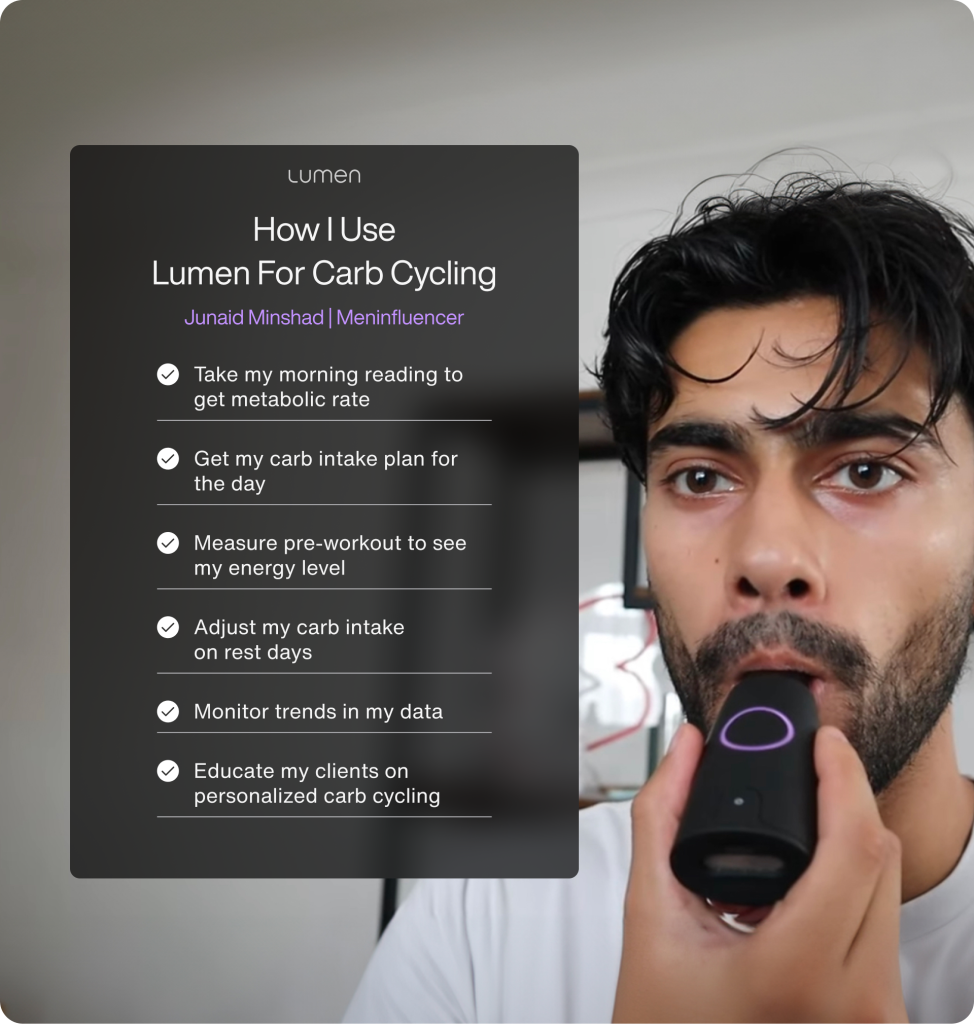Hey, fellas! Junaid Minshad here from Meninfluencer.com, and today, I’m stoked to share with you one of my secret weapons for optimizing my fitness game: Lumen. If you’re into carb cycling and want to take your results to the next level, you’re in for a treat. So, grab your favorite protein shake, settle in, and let’s dive into the science-backed world of Lumen and carb cycling.
Understanding the Basics: Lumen 101

Before we jump into the nitty-gritty of how I use Lumen for carb cycling, let’s get acquainted with the basics. Lumen is not your typical fitness gadget; it’s a metabolic tracker designed to provide real-time insights into your body’s fuel utilization. This small device analyzes your breath to determine whether you’re burning carbs or fats for energy.
The Science Behind Lumen
Lumen leverages the power of indirect calorimetry, a method validated by scientific research[^1^]. By measuring the ratio of carbon dioxide to oxygen in your breath, Lumen can accurately determine your metabolic state and guide your nutritional choices.
How I Use Lumen for Carb Cycling
1. Morning Ritual: Setting the Tone
Every morning, I start my day with a Lumen measurement. This sets the tone for my nutritional choices throughout the day. Here’s my approach:
- Low-Carb Days: If Lumen indicates a high reliance on fat for fuel, I lean towards a low-carb day. This helps me optimize fat burning and promote lean muscle maintenance[^2^].
- High-Carb Days: Conversely, if Lumen signals a preference for carbs, I gear up for a high-carb day. This strategic approach supports glycogen replenishment and enhances performance during intense workouts[^3^].
2. Pre-Workout Preparation
Lumen isn’t just a morning ritual for me; it’s also my pre-workout buddy. About 30 minutes before hitting the gym, I take another measurement. This helps me fine-tune my pre-workout nutrition:
- Carb Loading: On high-carb days, I might indulge in complex carbs to ensure I have the energy reserves needed for an efficient workout.
- Fasting: If Lumen suggests my body is in fat-burning mode, I might opt for a fasted workout to capitalize on maximizing fat utilization[^4^].
3. Post-Workout Refueling
Post-workout nutrition is crucial for recovery and muscle growth. Lumen guides me on the type and timing of my post-workout meal:
- Protein Emphasis: If Lumen indicates a higher protein need, I prioritize a protein-rich post-workout meal to support muscle repair and synthesis[^5^].
- Carb Inclusion: On high-carb days, I make sure to include sufficient carbs to replenish glycogen stores and optimize recovery.
Elevate Your Carb Cycling Game with Lumen
Incorporating Lumen into my carb cycling routine has been a game-changer. The personalized insights it provides empower me to make informed decisions about my nutrition, ensuring that I’m fueling my body for optimal performance and results.
But hey, don’t just take my word for it. Try it for yourself and witness the transformation. And here’s a little incentive for you—use the code MENBF90 to snag a sweet $90 OFF on your Lumen device. Trust me; it’s an investment in your fitness journey that’s totally worth it.
Glow Up Secrets Book: Your Free Pass to Turning Heads
Before you go, make sure to check out my Free Glow Up Secrets Book: The Underground Playbook For Turning Heads Everywhere You Go at meninfluencer.com/free. It’s packed with tips and tricks to take your overall charisma to the next level.
Connect with Me
If you’re vibing with these tips and want more personalized guidance, hit me up on Instagram @JunaidMinshad. I’m here to share the journey and learn from each other.
Ready to Take the Next Step?
Feeling inspired and ready to elevate your fitness game? Get a FREE consultation call with us at calendly.com/teamwcoach/15min. Let’s chat about your goals and how we can crush them together.
Now go out there, carb cycle like a pro, and let Lumen light the way!
[^1^]: Westerterp, K. R. (2017). Control of Energy Expenditure in Humans. In Biochemistry of Exercise, 73-90.[^2^]: Paoli, A., Rubini, A., Volek, J. S., & Grimaldi, K. A. (2013). Beyond weight loss: a review of the therapeutic uses of very-low-carbohydrate (ketogenic) diets. European Journal of Clinical Nutrition, 67(8), 789-796.
[^3^]: Burke, L. M., Hawley, J. A., Wong, S. H. S., & Jeukendrup, A. E. (2011). Carbohydrates for training and competition. Journal of Sports Sciences, 29(sup1), S17-S27.
[^4^]: Schoenfeld, B. J., Aragon, A. A., & Krieger, J. W. (2015). Effects of meal frequency on weight loss and body composition: a meta-analysis. Nutrition Reviews, 73(2), 69-82.
[^5^]: Morton, R. W., Murphy, K. T., McKellar, S. R., Schoenfeld, B. J., Henselmans, M., Helms, E., … & Phillips, S. M. (2018). A systematic review, meta-analysis and meta-regression of the effect of protein supplementation on resistance training-induced gains in muscle mass and strength in healthy adults. British Journal of Sports Medicine, 52(6), 376-384.




